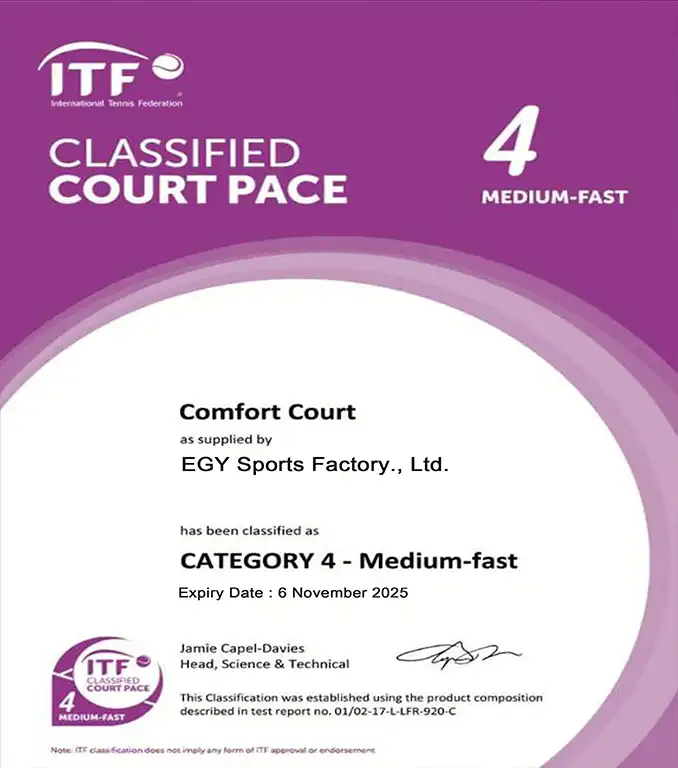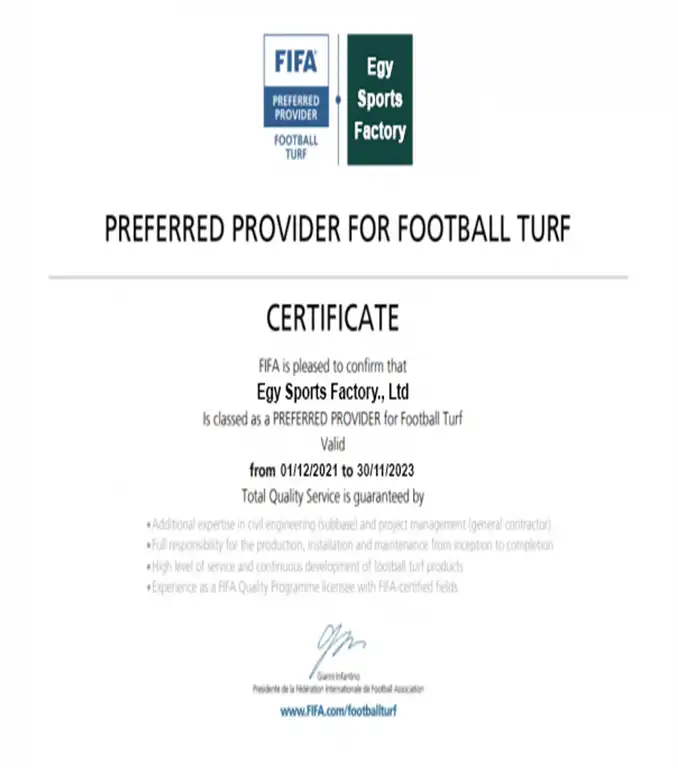Material
Fibrillated or monofilament
Fibrillated or monofilament
Final checks
Throughout the process there are quality checks. These include checking the consistency, application and weight of the latex or PU material that is used, monitoring the temperature of the ovens, checking the backing has dried and drainage holes are correctly applied. Final checks are essential to the finished quality and involve visual inspection and specific product tests.
Each roll is monitored as it comes through an inspection area, immediately before it is rolled up and wrapped for delivery. Here checks are made on the strength of the tuft lock, the length of the fibre, density of stitches and other quality control measurements. These are recorded in the event of a future issue.
Under artificial light it is not always possible to pick up flaws in the turf, although the inspection area is as well-lit as possible. Occasionally spot checks will include taking a complete roll outside, unrolling under natural light, and checking for product consistency, colour differences and line straightness.
Having confirmed the quality of the produced turf, the artificial grass manufacturing side is complete.

Next, we will look at the importance of the roll-up unit, preparation for delivery and final dispatch.
After Production – Wrapping, Packing, Shipping and Unloading
Having made great synthetic turf, it is important it arrives at its final destination in perfect condition.
Once turf is backed and checked it is rolled up tightly, ready for dispatch. This may sound simple, but if not performed correctly can lead to a variety of problems on site. These range from rolls becoming loose during transport, and subsequently very hard to unroll, or creases forming within the turf. To prevent issues, the roll-up unit pulls the turf tight as it is fed through, before it is cut to the required length.
The rolls are wrapped in plastic covering, secured at each end, to prevent water seeping in when on site. Each roll is numbered and will correspond with a location on the layout plan.
Rolls are placed into the transport container, by long booms on heavyweight forklift trucks, either onto the floor or on top of other rolls. Large rolls may be stacked 3 high, whereas smaller rolls (less weight) can have more in a stack. To prevent damage the container floor and sides are lined with strong cardboard.
Ideally rolls are transported from factory to site, without double handling at any point. The appointed shipping agent will handle dispatch to the destination port, where a local shipping agent will arrange for duties and port costs to be paid by the synthetic turf purchaser, before shipping to site.
To unload the rolls from the container a forklift with a long boom is needed. The boom is inserted through the central tube, to the far end, and then the roll is lifted out of the container. Rolls further back in the container are pulled forward, until the boom can lift them cleanly from the container.
Incorrect equipment (short boom), or poor unloading techniques (boom not in far enough) can cause the inner tube to break. This in turn can “pinch” the turf, creating small creases. Care should also be taken to ensure that each roll’s identity sheet is still attached. This helps with ensuring rolls are placed into their correct position, before unrolling.
EgySports, a top tier artificial grass manufacturer, is dedicated to providing the best artificial turf for both sports and landscape purposes. To learn more about artificial grass, please check out the official Egy Sports website. If you have any further questions about artificial grass manufacturing, please feel free to call +201096165656 or email: info@egysportsfactory.com
Final checks
Throughout the process there are quality checks. These include checking the consistency, application and weight of the latex or PU material that is used, monitoring the temperature of the ovens, checking the backing has dried and drainage holes are correctly applied. Final checks are essential to the finished quality and involve visual inspection and specific product tests.
Each roll is monitored as it comes through an inspection area, immediately before it is rolled up and wrapped for delivery. Here checks are made on the strength of the tuft lock, the length of the fibre, density of stitches and other quality control measurements. These are recorded in the event of a future issue.
Under artificial light it is not always possible to pick up flaws in the turf, although the inspection area is as well-lit as possible. Occasionally spot checks will include taking a complete roll outside, unrolling under natural light, and checking for product consistency, colour differences and line straightness.
Having confirmed the quality of the produced turf, the artificial grass manufacturing side is complete.

Next, we will look at the importance of the roll-up unit, preparation for delivery and final dispatch.
After Production – Wrapping, Packing, Shipping and Unloading
Having made great synthetic turf, it is important it arrives at its final destination in perfect condition.
Once turf is backed and checked it is rolled up tightly, ready for dispatch. This may sound simple, but if not performed correctly can lead to a variety of problems on site. These range from rolls becoming loose during transport, and subsequently very hard to unroll, or creases forming within the turf. To prevent issues, the roll-up unit pulls the turf tight as it is fed through, before it is cut to the required length.
The rolls are wrapped in plastic covering, secured at each end, to prevent water seeping in when on site. Each roll is numbered and will correspond with a location on the layout plan.
Rolls are placed into the transport container, by long booms on heavyweight forklift trucks, either onto the floor or on top of other rolls. Large rolls may be stacked 3 high, whereas smaller rolls (less weight) can have more in a stack. To prevent damage the container floor and sides are lined with strong cardboard.
Ideally rolls are transported from factory to site, without double handling at any point. The appointed shipping agent will handle dispatch to the destination port, where a local shipping agent will arrange for duties and port costs to be paid by the synthetic turf purchaser, before shipping to site.
To unload the rolls from the container a forklift with a long boom is needed. The boom is inserted through the central tube, to the far end, and then the roll is lifted out of the container. Rolls further back in the container are pulled forward, until the boom can lift them cleanly from the container.
Incorrect equipment (short boom), or poor unloading techniques (boom not in far enough) can cause the inner tube to break. This in turn can “pinch” the turf, creating small creases. Care should also be taken to ensure that each roll’s identity sheet is still attached. This helps with ensuring rolls are placed into their correct position, before unrolling.
EgySports, a top tier artificial grass manufacturer, is dedicated to providing the best artificial turf for both sports and landscape purposes. To learn more about artificial grass, please check out the official Egy Sports website. If you have any further questions about artificial grass manufacturing, please feel free to call +201096165656 or email: info@egysportsfactory.com




















Newsletter
- © Copyright 2023 by EGY Sports Factory
